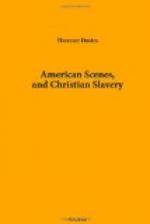In a serious yet coaxing tone, she said, “Won’t you take a seat here on this side of the aisle?”
“No, thank you, madam,” I replied; “we are quite comfortable.”
“But,” she continued, in a voice of deep commiseration, “this is the place allotted to the coloured people.”
“Thank you,” I rejoined; “we have made no mistake.”
“Well, just as you please, sir!” (as though she had said De gustibus non disputandum) and with that she retreated.
The eyes of all in the synagogue were upon us. The little people whispered, and the big people stared, and all the people marvelled.
The morning was dark and wet, and yet (as usual) the Venetian blinds were all down. The gallery was occupied by three classes of persons: the black people—about a dozen in number—on the “right hand,” the singing people in front, and the Sunday-school children everywhere else. The regular congregation, amounting perhaps to 300, were all downstairs.
Dr. Patton ascended the pulpit-stairs with his cloak on, placed a manuscript “fresh from the mint” under the cushion, sat down, took out his pocket-handkerchief, applied it vigorously, and then gazed leisurely around.
The pulpit service commenced with a short prayer; then followed singing by the choir, all else sitting silent. The tenth chapter of Romans was read; then came the long prayer, in which the Doctor prayed for the abolition of slavery, and for the spread of the Gospel. The text, which succeeded, was Rom. x. 3, 4. Having noticed the context, the preacher proposed—
I. To explain the text. (Here he examined very critically the meaning of the Greek word [Greek: dikai-osunous], quoting Moses Stuart and others.)
II. To designate those who go about to establish their own righteousness.
III. To remonstrate against such conduct, as being unnecessary, criminal, and dangerous.




